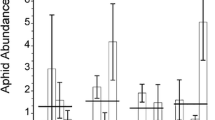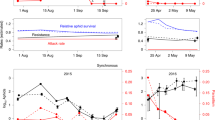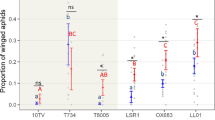Abstract
Genetic variation and contemporary evolution within populations can shape the strength and nature of species interactions, but the relative importance of these forces compared to other ecological factors is unclear. We conducted a field experiment testing the effects of genotypic variation, abundance, and presence/absence of green peach aphids (Myzus persicae) on the growth, leaf nitrogen, and carbon of two plant species (Brassica napus and Solanum nigrum). Aphid genotype affected B. napus but not S. nigrum biomass explaining 20 and 7 % of the total variation, respectively. Averaging across both plant species, the presence/absence of aphids had a 1.6× larger effect size (Cohen’s d) than aphid genotype, and aphid abundance had the strongest negative effects on plant biomass explaining 29 % of the total variation. On B. napus, aphid genotypes had different effects on leaf nitrogen depending on their abundance. Aphids did not influence leaf nitrogen in S. nigrum nor leaf carbon in either species. We conducted a second experiment in the field to test whether contemporary evolution could affect plant performance. Aphid populations evolved in as little as five generations, but the rate and direction of this evolution did not consistently vary between plant species. On one host species (B. napus), faster evolving populations had greater negative effects on host plant biomass, with aphid evolutionary rate explaining 23 % of the variation in host plant biomass. Together, these results show that genetic variation and evolution in an insect herbivore can play important roles in shaping host plant ecology.







Similar content being viewed by others
References
Abrams PA (2000) The evolution of predator–prey interactions: theory and evidence. Annu Rev Ecol Syst 31:79–105
Agashe D (2009) The stabilizing effect of intraspecific genetic variation on population dynamics in novel and ancestral habitats. Am Nat 174:255–267. doi:10.1086/600085
Agrawal AA (2000) Host-range evolution: adaptation and trade-offs in fitness of mites on alternative hosts. Ecology 81:500–508
Agrawal AA, Underwood N, Stinchcombe JR (2004) Intraspecific variation in the strength of density dependence in aphid populations. Ecol Entomol 29:521–526
Agrawal AA, Hastings AP, Johnson MTJ et al (2012) Insect herbivores drive real-time ecological and evolutionary change in plant populations. Science 338:113–116. doi:10.1126/science.1225977
Antonovics J (1976) The input from population genetics: “the new ecological genetics”. Syst Bot 1:233–245
Bailey JK, Schweitzer JA, Ubeda F et al (2009) From genes to ecosystems: a synthesis of the effects of plant genetic factors across levels of organization. Philos Trans R Soc Lond B 364:1607–1616. doi:10.1098/rstb.2008.0336
Bassar RD, Marshall MC, Lopez-Sepulcre A et al (2010) Local adaptation in Trinidadian guppies alters ecosystem processes. Proc Natl Acad Sci USA 107:3616–3621. doi:10.1073/pnas.0908023107
Blackman RL, Eastop VF (2008) Aphids on the world’s herbaceous plants and shrubs. Wiley, Chichester
Bohannan B, Lenski RE (2000) Linking genetic change to community evolution: insights from studies of bacteria and bacteriophage. Ecol Lett 3:362–377
Bolnick DI, Svanbäck R, Fordyce JA et al (2003) The ecology of individuals: incidence and implications of individual specialization. Am Nat 161:1–28. doi:10.1086/343878
Bone E, Farres A (2001) Trends and rates of microevolution in plants. Genetica 112:165–182
Brues CT (1924) The specificity of food-plants in the evolution of phytophagous insects. Am Nat 58:127–144
Carriére Y, Crowder DW, Tabashnik BE (2010) Evolutionary ecology of insect adaptation to Bt crops. Evol Appl 3:561–573. doi:10.1111/j.1752-4571.2010.00129.x
Cohen J (1988) Statistical power analysis for the behavioral sciences. Lawrence Erlbaum, Hillsdale
Cole RA (1997) The relative importance of glucosinolates and amino acids to the development of two aphid pests Brevicoryne brassicae and Myzus persicae on wild and cultivated Brassica species. Entomol Exp Appl 85:121–133
Devonshire AL, Field LM, Foster SP et al (1998) The evolution of insecticide resistance in the peach-potato aphid, Myzus persicae. Philos Trans R Soc Lond B 353:1677–1684. doi:10.1098/rstb.1998.0318
Dyer KF (1964) Evolution observed—some examples of evolution occurring in historical. J Biol Educ 1–25
Edmonds JM, Chweya JA (1997) Black Nightshades, Solanum nigrum L. and related species. Institute of Plant Genetics and Crop Plant Research, Rome
Edmunds GF, Alstad DN (1978) Coevolution in insect herbivores and conifers. Science 199:941–945
Edwards OR (2001) Interspecific and intraspecific variation in the performance of three pest aphid species on five grain legume hosts. Entomol Exp Appl 100:21–30. doi:10.1046/j.1570-7458.2001.00844.x
Emden H, Eastop VF, Hughes RD, Way MJ (1969) The ecology of Myzus persicae. Annu Rev Entomol 14:197–270
Eskin NAM, Mcdonald BE (1991) Canola oil. Nutr Bull 16:138–146. doi:10.1111/j.1467-3010.1991.tb01048.x
Farkas TE, Mononen T, Comeault AA et al (2013) Evolution of camouflage drives rapid ecological change in an insect community. Curr Biol 23:1835–1843. doi:10.1016/j.cub.2013.07.067
Fenton B, Margaritopoulos JT, Malloch GL, Foster SP (2010) Micro-evolutionary change in relation to insecticide resistance in the peach-potato aphid, Myzus persicae. Ecol Entomol 35:131–146
Foster JE, Ohm HW, Patterson FL, Taylor PL (1991) Effectiveness of deploying single gene resistances in wheat for controlling damage by the hessian fly (Diptera: Cecidomyiidae). Environ Entomol 20:964–969
Foster SP, Denholm I, Devonshire AL (2000) The ups and downs of insecticide resistance in peach-potato aphids (Myzus persicae) in the UK. Crop Protect 19:873–879. doi:10.1016/S0261-2194(00)00115-0
Fox J, Weisberg S (2011) An {R} companion to applied regression, 2nd edn. Sage, Thousand Oaks. http://socserv.socsci.mcmaster.ca/jfox/Books/Companion
Fritz RS, Simms EL (1992) Plant resistance to herbivores and pathogens. University of Chicago Press, Chicago
Fry JD (1990) Trade-offs in fitness on different hosts—evidence from a selection experiment with a phytophagous mite. Am Nat 136:569–580
Fussmann GF, Loreau M, Abrams PA (2007) Eco-evolutionary dynamics of communities and ecosystems. Funct Ecol 21:465–477. doi:10.1111/j.1365-2435.2007.01275.x
Gould F (1979) Rapid host range evolution in a population of the phytophagous mite Tetranychus urticae Koch. Evolution 33:791–802
Gould F (1983) Genetics of plant–herbivore interactions. In: Denno RF, McClure MS (eds) Variable plants and herbivores in natural and managed systems. Academic, New York, pp 1–55
Gould F (1991) The evolutionary potential of crop pests. Am Sci 496–507
Hairston NG Jr, Ellner SP, Geber MA et al (2005) Rapid evolution and the convergence of ecological and evolutionary time. Ecol Lett 8:1114–1127. doi:10.1111/j.1461-0248.2005.00812.x
Hawkes CV, Sullivan JJ (2001) The impact of herbivory on plants in different resource conditions: a meta-analysis. Ecology 82:2045–2058
Hersch-Green EI, Turley NE, Johnson MTJ (2011) Community genetics: what have we accomplished and where should we be going? Philos Trans R Soc Lond B 366:1453–1460. doi:10.1098/rstb.2010.0331
Johnson MTJ, Agrawal AA (2005) Plant genotype and environment interact to shape a diverse arthropod community on evening primrose (Oenothera biennis). Ecology 86:874–885. doi:10.2307/3450841?ref=search-gateway:cffd26a81676b216725bdea740155185
Johnson MTJ, Vellend M, Stinchcombe JR (2009) Evolution in plant populations as a driver of ecological changes in arthropod communities. Philos Trans R Soc Lond B 364:1593–1605. doi:10.1098/rstb.2008.0334
Kant MR, Sabelis MW, Haring MA, Schuurink RC (2008) Intraspecific variation in a generalist herbivore accounts for differential induction and impact of host plant defences. Proc R Soc Lond B 275:443–452. doi:10.1098/rspb.2007.1277
Karban R (1989) Fine-scale adaptation of herbivorous thrips to individual host plants. Nature 340:60–61
Karban R, Baldwin IT (1997) Induced responses to herbivory. University of Chicago Press, Chicago
Kessler A, Baldwin IT (2002) Plant responses to insect herbivory: the emerging molecular analysis. Annu Rev Plant Biol 53:299–328. doi:10.1146/annurev.arplant.53.100301.135207
Kinnison MT, Hendry AP (2001) The pace of modern life II: from rates of contemporary microevolution to pattern and process. Genetica 112:145–164
Loxdale HD (2010) Rapid genetic changes in natural insect populations. Ecol Entomol 35:155–164. doi:10.1111/j.1365-2311.2009.01141.x
Maddox GD, Root RB (1987) Resistance to 16 diverse species of herbivorous insects within a population of goldenrod, Solidago altissima: genetic variation and heritability. Oecologia 72:8–14
Maron JL, Crone E (2006) Herbivory: effects on plant abundance, distribution and population growth. Proc R Soc Lond B 273:2575–2584. doi:10.1073/pnas.94.4.1252
Meihls LN, Higdon ML, Siegfried BD et al (2008) Increased survival of western corn rootworm on transgenic corn within three generations of on-plant greenhouse selection. Proc Natl Acad Sci USA 105:19177–19182
Meyer JR, Ellner SP, Hairston NG et al (2006) Prey evolution on the time scale of predator–prey dynamics revealed by allele-specific quantitative PCR. Proc Natl Acad Sci USA 103:10690–10695
Miles PW (2007) Aphid saliva. Biol Rev 74:41–85. doi:10.1111/j.1469-185X.1999.tb00181.x
Mopper S (1996) Adaptive genetic structure in phytophagous insect populations. Trends Ecol Evol 11:235–238
Normark BB, Johnson NA (2011) Niche explosion. Genetica 139:551–564
Nosil P, Crespi BJ, Sandoval CP (2002) Host-plant adaptation drives the parallel evolution of reproductive isolation. Nature 417:440–443. doi:10.1038/417440a
Painter RH (1931) Resistance of varieties of winter wheat to Hessian fly, Phytophaga destructor. Kansas Agric Exp Stn Bull 27:1–58
Pathak PK, Heinrichs EA (1982) Selection of biotype populations 2 and 3 of Nilaparvata lugens by exposure to resistant rice varieties. Environ Entomol 11:85–90
Pathak MD, Painter RH (1959) Geographical distribution of the four biotypes of corn leaf aphid, Rhopalosiphum maidis (Fitch) in Kansas. Trans Kansas Acad Sci 62:1. doi:10.2307/3626498
Pimentel D (1968) Population regulation and genetic feedback. Science 159:1432–1437
Post DM, Palkovacs EP (2009) Eco-evolutionary feedbacks in community and ecosystem ecology: interactions between the ecological theatre and the evolutionary play. Philos Trans R Soc Lond B 364:1629–1640. doi:10.1098/rstb.2009.0012
Post DM, Palkovacs EP, Schielke EG, Dodson SI (2008) Intraspecific variation in a predator affects community structure and cascading trophic interactions. Ecology 89:2019–2032
R Core Team (2013) R: a language and environment for statistical computing. R Foundation for Statistical Computing, Vienna. http://www.R-project.org/
Rainey PB, Travisano M (1998) Adaptive radiation in a heterogeneous environment. Nature 394:69–72
Rakow G, Woods DL (1987) Outcrossing in rape and mustard under Saskatchewan prairie conditions. Can J Plant Sci 67:147–151. doi:10.4141/cjps87-017
Rausher MD (2001) Co-evolution and plant resistance to natural enemies. Nature 411:857–864. doi:10.1038/35081193
Rodriguez-Saona CR, Musser RO, Vogel H et al (2010) Molecular, biochemical, and organismal analyses of tomato plants simultaneously attacked by herbivores from two feeding guilds. J Chem Ecol 36:1043–1057. doi:10.1007/s10886-010-9854-7
Schmidt DD, Kessler A, Kessler D et al (2004) Solanum nigrum: a model ecological expression system and its tools. Mol Ecol 13:981–995. doi:10.1111/j.1365-294X.2004.02111.x
Schulte RD, Makus C, Hasert B et al (2010) Multiple reciprocal adaptations and rapid genetic change upon experimental coevolution of an animal host and its microbial parasite. Proc Natl Acad Sci USA 107:7359–7364. doi:10.1073/pnas.1003113107
Singer MC, Thomas CD, Parmesan C (1993) Rapid human-induced evolution of insect–host associations. Nature 366:681–683
Sloane MA, Sunnucks P, Wilson AC, Hales DF (2001) Microsatellite isolation, linkage group identification and determination of recombination frequency in the peach-potato aphid, Myzus persicae (Sulzer) (Hemiptera: Aphididae). Genet Res 77:251–260
Soria-Carrasco V, Gompert Z, Comeault AA et al (2014) Stick insect genomes reveal natural selection’s role in parallel speciation. Science 344:738–742. doi:10.1126/science.1252136
Strauss SY (1997) Lack of evidence for local adaptation to individual plant clones or site by a mobile specialist herbivore. Oecologia 110:77–85
Tabashnik BE, Van Rensburg JBJ, Carriére Y (2009) Field-evolved insect resistance to Bt crops: definition, theory, and data. J Econ Entomol 102:2011–2025
Tack AJM, Roslin T (2010) Overrun by the neighbors: landscape context affects strength and sign of local adaptation. Ecology 91:2253–2260
Tetard-Jones C, Kertesz MA, Gallois P, Preziosi RF (2007) Genotype-by-genotype interactions modified by a third species in a plant–insect system. Am Nat 170:492–499. doi:10.1086/520115
Thompson JN (1998) Rapid evolution as an ecological process. Trends Ecol Evol 13:329–332
Thompson JN (2013) Relentless evolution. University of Chicago Press, Chicago
Turcotte MM, Reznick DN, Hare JD (2011) The impact of rapid evolution on population dynamics in the wild: experimental test of eco-evolutionary dynamics. Ecol Lett 14:1084–1092. doi:10.1111/j.1461-0248.2011.01676.x
Underwood N, Rausher MD (2000) The effects of host–plant genotype on herbivore population dynamics. Ecology 81:1565–1576
Utsumi S (2011) Eco-evolutionary dynamics in herbivorous insect communities mediated by induced plant responses. Popul Ecol 53:23–34. doi:10.1007/s10144-010-0253-2
Van Zandt PA, Mopper S (1998) A meta-analysis of adaptive deme formation in phytophagous insect populations. Am Nat 152:595–604. doi:10.1086/286192
Via S (1990) Ecological genetics and host adaptation in herbivorous insects: the experimental study of evolution in natural and agricultural systems. Annu Rev Entomol 35:421–446. doi:10.1146/annurev.en.35.010190.002225
Viswanathan DV, Narwani AJ, Thaler JS (2005) Specificity in induced plant responses shapes patterns of herbivore occurrence on Solanum dulcamara. Ecology 86:886–896
von Burg S, Ferrari J, Muller CB, Vorburger C (2008) Genetic variation and covariation of susceptibility to parasitoids in the aphid Myzus persicae: no evidence for trade-offs. Proc R Soc Lond B 275:1089–1094. doi:10.1126/science.1094611
Vorburger C (2006) Temporal dynamics of genotypic diversity reveal strong clonal selection in the aphid Myzus persicae. J Evol Biol 19:97–107. doi:10.1111/j.1420-9101.2005.00985.x
Vorburger C, Sunnucks P, Ward SA (2003) Explaining the coexistence of asexuals with their sexual progenitors: no evidence for general-purpose genotypes in obligate parthenogens of the peach-potato aphid, Myzus persicae. Ecol Lett 6:1091–1098. doi:10.1046/j.1461-0248.2003.00536.x
Walling LL (2000) The myriad plant responses to herbivores. J Plant Growth Regul 19:195–216. doi:10.1007/s003440000026
Wasserman SS, Futuyma DJ (1981) Evolution of host plant utilization in laboratory populations of the southern cowpea weevil, Callosobruchus maculatus Fabricius (Coleoptera: Bruchidae). Evolution 605–617
Weber G (1986) Ecological genetics of host plant exploitation in the green peach aphid, Myzus persicae. Entomol Exp Appl 40:161–168
Whitham TG, Young WP, Martinsen GD et al (2003) Community and ecosystem genetics: a consequence of the extended phenotype. Ecology 84:559–573. doi:10.2307/3107845?ref=search-gateway:bb6c26f53ae3213567b80e08cf30c839
Wilson AC, Massonnet B, Simon JC et al (2004) Cross-species amplification of microsatellite loci in aphids: assessment and application. Mol Ecol Notes 4:104–109. doi:10.1046/j.1471-8286.2003.00584.x
Wimp GM, Martinsen GD, Floate KD et al (2005) Plant genetic determinants of arthropod community structure and diversity. Evolution 59:61–69. doi:10.1111/j.0014-3820.2005.tb00894.x
Yoshida T, Ellner SP, Jones LE et al (2007) Cryptic population dynamics: rapid evolution masks trophic interactions. PLoS Biol 5:e235. doi:10.1371/journal.pbio.0050235.sd002
Zust T, Heichinger C, Grossniklaus U et al (2012) Natural enemies drive geographic variation in plant defenses. Science 338:116–119. doi:10.1126/science.1226397
Acknowledgments
We thank Chad Carter and the Lake Wheeler Field Laboratory staff for preparing and maintaining our field site. Aneil Agrawal, Spencer Barrett, Warren Booth, Hannah Burrack, Rob Dunn, Steve Frank, Fred Gould, Kevin Gross, Nick Haddad, George Kennedy, and Coby Schal provided helpful insight and advice. We thank Carole Saravitz and Janet Shurtleff at the NCSU Phytotron for help in growing plants. Pauline Fung and Pauline Wang at the Centre for the Analysis of Genome Evolution and Function conducted microsatellite fragment length analyses. Wil Bolin, Geoff Broadhead, Diego Carmona, Will Fields, Rose Grinnan, Erika Hersch-Green, Elizabeth Hassell, Susan Jaconis, Yvonne Ly, H. Cassi Myburg, W. Clifton Odell, Ashish Parmar, Bobby San Miguel, Frances Sivakoff, Dave Stephan, and Christina Thomsen provided assistance in the lab and the field. Brassica napus seeds were generously donated by Jim Davis (U. Idaho). Funding was provided by a National Science Foundation Graduate Research Fellowship to N.E.T., NC State University, and NSERC Canada to M.T.J.J.
Author information
Authors and Affiliations
Corresponding author
Additional information
Communicated by Moshe Inbar.
Electronic supplementary material
Below is the link to the electronic supplementary material.
Rights and permissions
About this article
Cite this article
Turley, N.E., Johnson, M.T.J. Ecological effects of aphid abundance, genotypic variation, and contemporary evolution on plants. Oecologia 178, 747–759 (2015). https://doi.org/10.1007/s00442-015-3276-8
Received:
Accepted:
Published:
Issue Date:
DOI: https://doi.org/10.1007/s00442-015-3276-8




